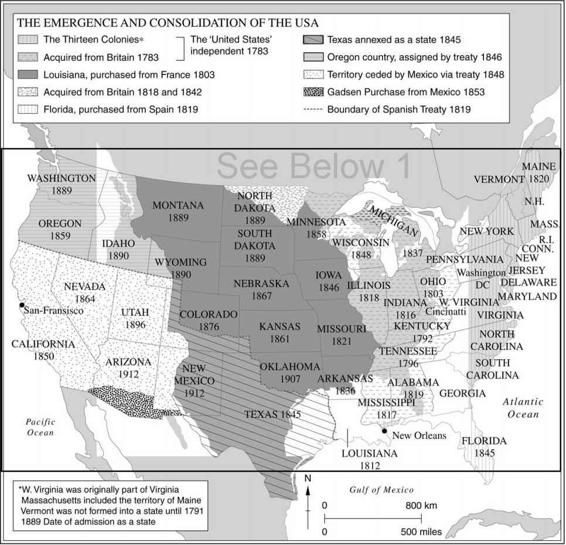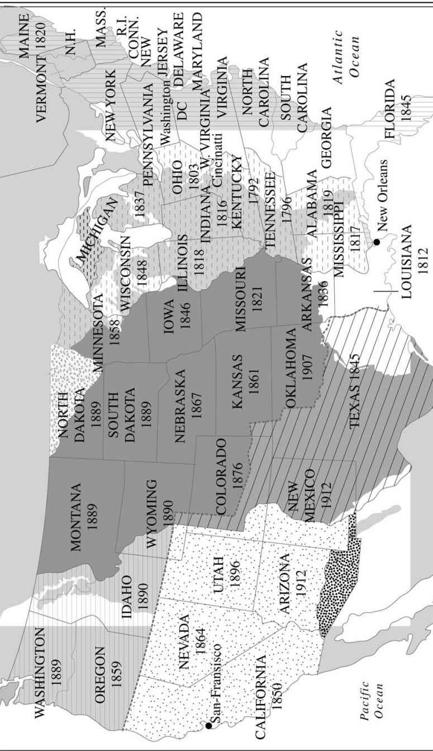The New Penguin History of the World (136 page)
Read The New Penguin History of the World Online
Authors: J. M. Roberts,Odd Arne Westad

Victory in war was followed by a half-dozen critical years during which a handful of American politicians took decisions which were to shape much of the future history of the world. As in all civil wars and wars of independence, new divisions had been created which accentuated political weakness. Among these, those which divided loyalists from rebels were, for all their bitterness, perhaps the least important. That problem had been solved, brutally, by emigration of the defeated; something like 80,000 loyalists left the rebel colonies, for a variety of motives ranging from dislike of intimidation and terror to simple loyalty to the Crown. Other divisions were likely to cause more trouble in the future. Class and economic interests separated farmers, merchants and plantation-owners. There were important differences between the new states which had replaced the former colonies and between the regions or sections of a rapidly developing country; one of these, that imposed by the economic importance of black slavery to the southern states, was to take decades to work out. On the other hand, the Americans also had great advantages as they set about nation-building. They faced the future without the incubus of a huge illiterate and backward peasant population such as stood in the way of evolving a democratic system in many other countries. They had ample territory and great economic resources even in their existing areas of occupation. Finally, they had European civilization to draw upon, subject only to the modifications its legacies might undergo in transplantation to a virgin – or near-virgin – continent.
The war against the British had imposed a certain discipline. Articles of
Confederation had been agreed between the former colonies and came into force in 1781. In them appeared the name of the new nation, the United States of America. The peace brought a growing sense that these arrangements were unsatisfactory. There were two areas of particular concern. One was disturbance arising fundamentally from disagreement about what the Revolution ought to have meant in domestic affairs. The central government came to many Americans to appear to be far too weak to deal with disaffection and disorder. The other arose from a post-war economic depression, particularly affecting external trade and linked to currency problems arising from the independence of individual states. To deal with these as well, the central government seemed ill-equipped. It was accused of neglecting American economic interests in its conduct of relations with other countries. Whether true or not, this was widely believed. The outcome was a meeting of delegates from the states in a constitutional convention at Philadelphia in 1787. After four months’ work they signed a draft constitution, which was then submitted to the individual states for ratification. When nine states had ratified it the constitution came into effect in the summer of 1788. In April 1789 George Washington, the former commander of the American forces in the war against the British, took the oath of office as the first president of the new republic, thus inaugurating a series of presidencies which has continued unbroken to this day.
Much was said about the need for simple institutions and principles clear in their intention, yet the new constitution was still to be revealing its potential for development two hundred years later. For all the determination of its drafters to provide a document which would unambiguously resist reinterpretation, they were (fortunately) unsuccessful. The United States constitution was to prove capable of spanning a historical epoch, which turned a scatter of largely agricultural societies into a giant and industrial world power. In part this was because of the provision for conscious amendment, but in larger measure it was due to the evolving interpretation of the doctrines it embodied. But also much remained unchanged; though often formal, these features of the constitution are very important. Besides them, too, there were fundamental principles which were to endure, even if there was much argument about what they might mean.
To begin with the most obvious fact: the constitution was republican. This was by no means normal in the eighteenth century and should not be taken for granted. Some Americans felt that republicanism was so important and so insecure that they even disapproved of the constitution because they thought it (and particularly its installation of a president as the head of the executive) ‘squinted towards monarchy’, as one of them put it. The ancient republics were as familiar to classically educated Europeans for their tendency to decay and faction as for their legendarily admirable morals. The history of the Italian republics was unpromising, too, and much more unedifying than that of Athens and Rome. Republics in eighteenth-century Europe were few and apparently unflourishing. They seemed to persist only in small states, though it was conceded that the remoteness of the United States might protect republican forms which would elsewhere ensure the collapse of a large state. Still, observers were not sanguine about the new nation. The later success of the United States was therefore to be of incalculable importance in reversing opinion about republicanism. Very soon, its capacity to survive, its cheapness and a liberalism mistakenly thought to be inseparable from it focused the attention of critics of traditional governments all over the civilized world. European advocates of political change soon began to look to America for inspiration; soon, too, the influence of republican example was to spread from the northern to the southern American continent.



The second characteristic of the new constitution, which was of fundamental
importance, was that its roots lay largely in British political experience. Besides the law of England, whose Common Law principles passed into the jurisprudence of the new state, this was true also of the actual arrangement of government. The founding fathers had all grown up in the British colonial system in which elected assemblies had debated the public interest with monarchical governors. They instituted a bicameral legislature (although they excluded any hereditary element in its composition) on the English model, to offset a president. They thus followed English constitutional theory in putting a monarch, albeit an elected one, at the head of the executive machinery of government. Though, in a different sense, the British had an elected monarchy, this was not how the British constitution of the eighteenth century actually worked, but it was a good approximation to its appearance. The founding fathers took, in fact, the best constitution they knew, purged it of its corruptions (as they saw them) and added modifications appropriate to American political and social circumstance. What they did not do was to emulate the alternative principle of government available in contemporary Europe – monarchical absolutism – even in its enlightened form. The Americans wrote a constitution for free men because they believed that the British already lived under one. They thought it had failed only in so far as it had been corrupted, and that it had been improperly employed to deprive Americans of the rights they too ought to have exercised under it. Because of this, the same principles of government (albeit in much evolved forms) would one day be propagated and patronized in areas which shared none of the cultural assumptions of the Anglo-Saxon world on which they rested.
One way in which the United States differed radically from most other existing states and diverged consciously from the British constitutional model was in adherence to the principle of federalism. This was indeed fundamental to it, since only large concessions to the independence of individual states made it possible for the new union to come into existence at all. The former colonies had no wish to set up a new central government which would bully them as they believed the government of King George had done. The federal structure provided an answer to the problem of diversity –
e pluribus unum
. It also dictated much of the form and content of American politics for the next eighty years. Question after question whose substance was economic or social or ideological would find itself pressed into the channels of a continuing debate about what were the proper relations of the central government and the individual states. It was a debate which would in the end come within an inch of destroying the Union. Federalism would also promote a major readjustment within the constitution, the rise of the Supreme Court as an instrument of judicial
review. Outside the Union, the nineteenth century would reveal the appeal of federalism to many other countries, impressed by what appeared to have been achieved by the Americans. Federalism was to be seen by European liberals as a crucial device for reconciling unity with freedom and British governments found it a great standby in their handling of colonial problems.
Finally, in any summary, however brief, of the historic significance of the constitution of the United States, attention must be given to its opening words: ‘We the People’ (even though they seem to have been included almost casually). The actual political arrangements in several of the states of 1789 were by no means democratic, but the principle of popular sovereignty was enunciated clearly from the start. In whatever form the mythology of a particular historical epoch might cloak it, the popular will was to remain the ultimate court of appeal in politics for Americans. Here was a fundamental departure from British constitutional practice, and it owed something to the way in which seventeenth-century colonists had sometimes given themselves constitutions. Yet British constitutionalism was prescriptive; the sovereignty of king in parliament was not there because the people had once decided it should be, but because it was there and was unquestioned. As the great English constitutional historian Maitland once put it, Englishmen had taken the authority of the Crown as a substitute for the theory of the state. The new constitution broke with this and with every other prescriptive theory (although not with British political thinking, for Locke had said in the 1680s that governments held their powers on trust and that the people could upset governments which abused that trust, and on this ground, among others, some Englishmen had justified the Glorious Revolution).
The American adoption of a democratic theory that all governments derive their just powers from the consent of the governed (as it had been put in the Declaration of Independence) was epoch-marking. But it by no means solved the problems of political authority at a stroke. Many Americans feared what a democracy might do and sought to restrict the popular element in the political system right from the start. Another problem was suggested by the fundamental rights set out in the first ten amendments to the constitution at the end of 1789. These were presumably as much open to reamendment at the hands of popular sovereignty as any other part of the constitution. Here was an important source of disagreement for the future: Americans have always found it easy to be somewhat confused (especially in the affairs of other countries but even in their own at times) about whether democratic principles consist in following the wishes of the majority or in upholding certain fundamental rights. Nevertheless, the
de
facto
adoption of the democratic principle in 1787 was immensely important and justifies the consideration of the constitution as a landmark in world history. For generations to come the new United States would become the focus of the aspirations of men longing to be free the world over – ‘the world’s last, best hope’, as one American once memorably said. Even today, when America so often appears conservative and inward-looking, the democratic ideal of which for so long it was the custodian and exemplar retains its power in many countries, and the institutions it fertilized are still working.
